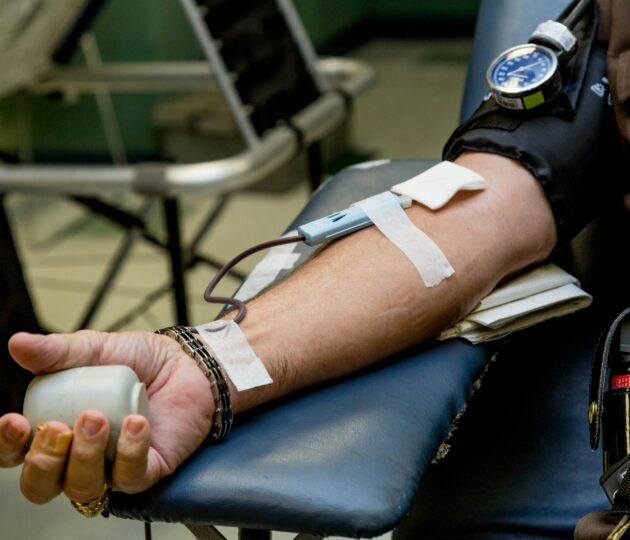blog:
World Blood Donor Day: How donating blood saves other people’s lives while improving your own

To celebrate the 20th anniversary of World Blood Donor Day, why not book an appointment to donate locally and experience the “warm glow” of playing a key part in improving people’s health and saving lives?
I was just a toddler, away on holiday with my parents, when they noticed my skin bruising from the slightest touch.
Panicked, they took me to a local doctor who quickly referred me to a hematologist. Not long after that, I was diagnosed with severe thrombocytopenia — low platelet count — and admitted to a hospital ward, where I spent the next few weeks. This was to be the only hospital stay of my childhood — once I recovered, the condition didn’t bother me again.
I didn’t think about that episode again until my friends started turning 18 and becoming regular blood donors. The temptation was huge — you spent a couple of hours at the donor center and were rewarded with not only several huge bars of chocolate but also a whole day off school! I was eager to start donating but I remembered my childhood platelet episode and wasn’t sure if I could be a donor.
Thankfully, with a high enough platelet count and way more than the required five years since full recovery, I was accepted… and I have been donating ever since, even after moving to another country.
I’m in good company; there are 118.54 million blood donations collected globally every year, and the decade between 2008 and 2018 saw an increase of 10.7 million voluntary unpaid donations.
As a woman, I am in the 33% of all donors, although in some countries, less than 10% of donations is from female donors. Admittedly, giving blood is more tricky for women, as donating blood is not permitted during pregnancy and breastfeeding, and some countries limit donation opportunities during and around menstruation. Female donors have also been heavily restricted from donating plasma, but new, “female-friendly” machines now enable the majority of women to become plasma donors.
Reasons for donating blood
A couple of decades and donor awards (recognizing round numbers of donations) later, the motivation that keeps me coming back to the donor center is more intrinsic. The World Health Assembly agrees that to keep a consistent, stable and safe blood supply, countries should rely on voluntary, unpaid and regular donors.
For me, a “thank you” from the donor center staff and a couple of biscuits are more than enough as they come with the realization that I am helping to save lives and improve people’s health. If this is not worth a couple of hours of my time every four months, then I don’t know what is!
In fact, research has shown that reinforcing the ”warm glow” associated with giving blood prompts donors to book their next donation appointment. After each donation, I get a follow-up text message to let me know which hospital used my blood, serving as a reminder that real people are getting the benefits of it.
Each blood donation can help up to three people, such as cancer patients undergoing chemotherapy. A blood cell transfusion uses on average three pints of blood — the equivalent of three separate donations — and a single car accident victim may need as many as 100 units of blood!
I have the most common blood group, O+, which means my blood can be given to patients with all Rh-positive groups. However, thanks to donating, I found out that my subtype, Ro, is very rare and required by people regularly receiving blood transfusions, such as those with sickle cell. These patients need blood from around 100 donors every year.
As part of the donation process, my blood is also regularly screened for several viruses and bacteria, including three types of hepatitis, HIV and HTLV, which gives me peace of mind without additional tests. Research also shows that donors have a much lower risk of developing cardiovascular disease (heart attack risk is reduced by up to 88% for regular donors) as well as cancer.
Recently, I learned about a benefit of regularly donating full blood or plasma that not many people may realize: It reduces the level of PFAS (known commonly as “forever chemicals,” known to have carcinogenic effects) in the bloodstream. More frequent plasma donations are even more effective for this purpose. Still, regular blood donations also work great, significantly reducing the ubiquitous toxins in the blood serum.
There is an ethical dilemma related to the fact that the donor transfers a portion of their PFAS to the patient, but the benefits of receiving blood far outweigh that risk as nowadays PFAS are present in everyone’s bloodstream.
Have you been persuaded to give blood donation a go? Or are you already a donor and some of the points above reinforced your resolve to keep donating?
World Blood Donor Day, celebrated in 2024 for the 20th time, is the perfect time to book your donation appointment, whether it is your first one or you have donated plenty of times already. Your mind and body will be all the better for it, but most importantly, you may save a life — or three.
References
Related news, insight and opinion




